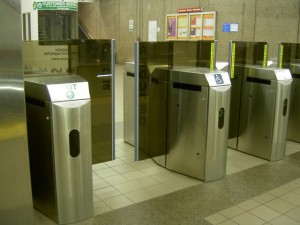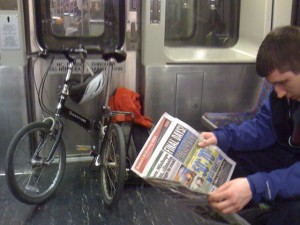The user-centered design considerations of the Boston subway are generally quite impressive. From personal experience as a subway rider, I had noticed some ways in which the process stumbled. So I decided to diagram the process to pinpoint how it could be improved.
Let me first emphasize that as a frequent rider, I personally love the Boston subway, commonly referred to as “the T”. The recently-upgraded gates are seamless and fairly secure, and they stay out of your way when you are exiting. Riders can pay fares using either a paper ticket or an RFID-enabled “Charlie Card” which can store value. The fare when using a Charlie Card is 30 cents cheaper than when using a ticket – so there is an incentive to reduce waste by avoiding paper tickets (not sure if that was the intent, but that is the effect). The fare kiosks are decent – I think there’s room for improvement there as well. Also, the MBTA (Massachusetts Bay Transportation Authority) website is packed with any information you would want to know about riding their buses / trains / boats. The maps and schedules are clear on their website as well as in their on-site signage. They take into consideration bringing bikes and pets onto the system and lay out the rules for what you can bring on and when.
I have plenty of experience in an edge case in this process – riding the T with a folding bike. The rules for “bikes on the T” indicate that folding bikes are allowed on the T at any time, but during peak hours, they must be folded.

Subway Gate. Photo Credit: Dan4th
Picture walking a bicycle as walking alongside a long pool while guiding a fish by holding it by its dorsal fin – the fish is long and narrow, and it works pretty smoothly as long as you don’t make any sudden turns.
Now picture carrying a 20-pound fish folded over sideways by your side as you are walking through a crowded subway station – that is what walking a folded bicycle is like. It doesn’t roll, it’s fairly heavy, and it is twice as wide.
From a systems point of view, the problem here is that the only checkpoint where the MBTA employees can control what goes in to the subway system and what doesn’t is at the gates. In a perfect world with unlimited resources, there would be another employee at the platform – making sure that bikes are folded as people board the train. Of course, that is not the case.
I’d be curious to see what the process is like for someone in a wheelchair using one of the lifts in a station without an elevated platform. I haven’t seen it in use yet, but I imagine it being quite awkward.

